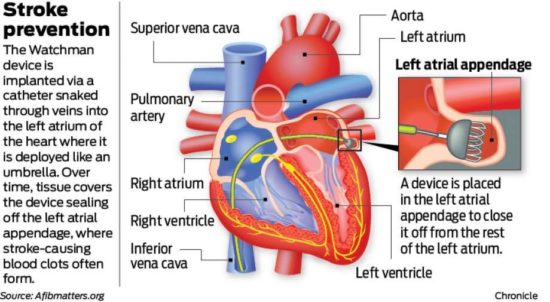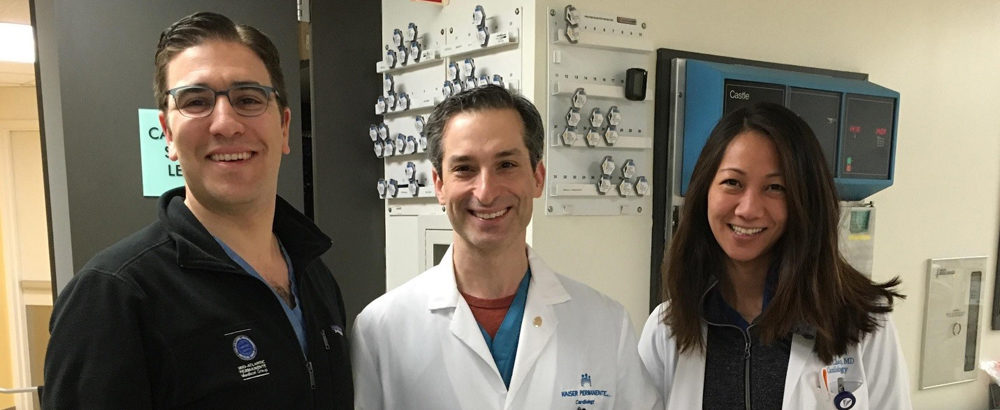Dr. Benjamin Galper, Dr. Jason Rashkin, and Dr. Tania Chao perform LAA Closure/Watchman Implant for members with atrial fibrillation
The Mid-Atlantic Permanente Medical Group (MAPMG) is among the first medical teams to perform the Left Atrial Appendage (LAA) Closure procedure, also known as the Watchman Implant. MAPMG takes its place among only a few medical teams selected to afford this opportunity to its members with atrial fibrillation. Through the Watchman procedure Kaiser Permanente upholds its commitment to offer members exceptional, industry-leading care options.
“We are proud to offer our members this treatment. It’s a new way of approaching stroke risk following a heart procedure,” said Dr. Jason Rashkin.
Dr. Rashkin, an electrophysiologist with special training in structural heart interventions, and his colleagues Dr. Benjamin Galper, an interventional cardiologist who specializes in structural heart interventions and Dr. Tania Chao, a non-invasive cardiologist who performs transesophageal echocardiography ultrasound imaging, are proudly called the Watchman Team. The team has successfully implanted the Watchman device in four patients.
Watchman Implant Candidate
The left atrial appendage (LAA) is a small wind-sock shaped structure that is part of the left atrium of the heart where blood can be stagnant and form clots in patients with atrial fibrillation. Patients with atrial fibrillation are at five times the risk of stroke compared with the general population because of clots that can form in the LAA and then travel to the brain.
Typically, patients with atrial fibrillation will take blood thinners like Coumadin or Pradaxa to reduce their risk of stroke, but many patients are intolerant of blood thinners because of severe bleeding events that can occur while taking blood thinning medication. By undergoing the Watchman procedure, patients will now be able to reduce their risk of stroke without needing to take blood thinner medications. Patients undergoing the Watchman procedure who were unable to take blood thinners will reduce their risk of stroke by 80%.
“In studies of patients with atrial fibrillation nearly 40 percent of patients have severe bleeding episodes or are intolerant to blood thinning medications. Our members can certainly benefit from the Watchman procedure,” said Dr. Galper.
Performing a Watchman Implant
 The Watchman Implant can be performed in roughly one hour. Patients are given general anesthesia, and the Watchman device, shaped like a small umbrella with a mesh outer layer over a metal scaffold, (See Figure 1: Schematic of Watchman Device) is placed in the body through a tiny incision in the right femoral vein (a major vein in the leg). Next, the device is advanced within a guiding sheath to the left atrium though a puncture that is made in the septum that separates the right and left atrium. The Watchman device is then placed in the LAA through both X-ray and ultrasound imaging. Before releasing the device, the doctors confirm, from multiple viewpoints and angles, that the device is perfectly seated in the LAA. Over the next 45 days, the patient’s heart tissue will grow over the Watchman device and completely seal off the LAA.
The Watchman Implant can be performed in roughly one hour. Patients are given general anesthesia, and the Watchman device, shaped like a small umbrella with a mesh outer layer over a metal scaffold, (See Figure 1: Schematic of Watchman Device) is placed in the body through a tiny incision in the right femoral vein (a major vein in the leg). Next, the device is advanced within a guiding sheath to the left atrium though a puncture that is made in the septum that separates the right and left atrium. The Watchman device is then placed in the LAA through both X-ray and ultrasound imaging. Before releasing the device, the doctors confirm, from multiple viewpoints and angles, that the device is perfectly seated in the LAA. Over the next 45 days, the patient’s heart tissue will grow over the Watchman device and completely seal off the LAA.
Patients generally stay overnight in the hospital and are released the following day. Patients are kept on blood thinning medications for 45 days or until the transesophageal echocardiography confirms that the LAA has been fully sealed by the implant. At this point patients can continue to use anti-platelet medications like aspirin and safely stop using blood thinning medications.
Members have been very satisfied following the Watchman procedure. “Our first implant patient was ecstatic when he learned that the procedure was a success, and is planning to take a long European vacation. He is encouraged to know that he will not be at risk of having a bleeding episode once he stops his blood thinner medication, and that due to cutting edge technology, he is protected from having a stroke,” said Dr. Galper.
Based on previous studies of the Watchman device there is a 2 – 4 percent risk of complication occurring during the procedure, including a 1-2 percent risk of a cardiac perforation which would require urgent intervention. Overall, there is a 95% likelihood of a completely successful device implantation.
MAPMG is excited to be able to offer the Watchman procedure to eligible members. The procedure allows us to provide members who are at an incredibly high risk of stroke from suffering a disabling stroke over the course of their lives.




